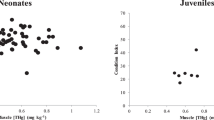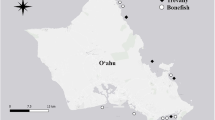Abstract
River otters are fish-eating wildlife that bioaccumulate high levels of mercury (Hg). Mercury is a proven neurotoxicant to mammalian wildlife, but little is known about the underlying, sub-clinical effects. Here, the overall goal was to increase understanding of Hg’s neurological risk to otters. First, Hg values across several brain regions and tissues were characterized. Second, in three brain regions with known sensitivity to Hg (brainstem, cerebellum, and occipital cortex), potential associations among Hg levels and neurochemical biomarkers [N-methyl-d-aspartic acid (NMDA) and gamma-aminobutyric acid (GABAA) receptor] were explored. There were no significant differences in Hg levels across eight brain regions (rank order, highest to lowest: frontal cortex, cerebellum, temporal cortex, occipital cortex, parietal cortex, basal ganglia, brainstem, and thalamus), with mean values ranging from 0.7 to 1.3 ug/g dry weight. These brain levels were significantly lower than mean values in the muscle (2.1 ± 1.4 ug/g), liver (4.7 ± 4.3 ug/g), and fur (8.8 ± 4.8 ug/g). While a significant association was found between Hg and NMDA receptor levels in the brain stem (P = 0.028, rp = −0.293), no relationships were found in the cerebellum and occipital cortex. For the GABA receptor, no relationships were found. The lack of consistent Hg-associated neurochemical changes is likely due to low brain Hg levels in these river otters, which are amongst the lowest reported.



Similar content being viewed by others
References
Basu N, Head J (2010) Mammalian wildlife as complementary models in environmental neurotoxicology. Neurotoxicol Teratol 32:114–119
Basu N, Scheuhammer AM, Grochowina N, Klenavic K, Evans RD, O’Brien M, Chan HM (2005) Effects of mercury on neurochemical receptors in wild river otters (Lontra canadensis). Environ Sci Technol 39:3585–3591
Basu N, Scheuhammer AM, Evans RD, O’Brien M, Chan HM (2007a) Cholinesterase and monoamine oxidase activity in relation to mercury levels in the cerebral cortex of wild river otters. Hum Exp Toxicol 26:213–220
Basu N, Scheuhammer AM, Rouvinen-Watt K, Grochowina N, Evans RD, O’Brien M, Chan HM (2007b) Decreased N-methyl-d-aspartic acid (NMDA) receptor levels are associated with mercury exposure in wild and captive mink. Neurotoxicology 28:587–593
Basu N, Scheuhammer AM, Sonne C, Letcher RJ, Born EW, Dietz R (2009) Is dietary mercury of neurotoxicological concern to wild polar bears (Ursus maritimus)? Environ Toxicol Chem 28:133–140
Basu N, Scheuhammer AM, Rouvinen-Watt K, Evans RD, Trudeau VL, Chan LH (2010) In vitro and whole animal evidence that methylmercury disrupts GABAergic systems in discrete brain regions in captive mink. Comp Biochem Physiol C Toxicol Pharmacol 151:379–438
Bhavsar SP, Gewurtz SB, McGoldrick DJ, Keir MJ, Backus SM (2010) Changes in mercury levels in Great Lakes fish between 1970s and 2007. Environ Sci Technol 44:3273–3279
Bradford MM (1976) Rapid and sensitive method for the quantitation of microgram quantities of protein utilizing the principle of protein-dye binding. Anal Biochem 72:248–254
Clarkson TW, Magos L (2006) The toxicology of mercury and its chemical compounds. Crit Rev Toxicol 36:609–662
Engstrom DR, Swain EB (1997) Recent declines in atmospheric mercury deposition in the upper midwest. Environ Sci Technol 31:960–967
Evans RD, Addison EM, Villeneuve JY, McDonald KS, Joachim DG (2000) Distribution of inorganic and methylmercury among tissues in mink (Mustela vison) and otter (Lutra Canadensis). Environ Res 84(2):133–139
Evers DC, Wiener JG, Basu N, Bodaly RA, Morrison HA, Williams KA (2011) Mercury in the Great Lakes region: bioaccumulation, spatial and temporal patterns, ecological risks, and policy. Ecotoxicology 20:1487–1499
Haines KJ, Evans RD, O’Brien M, Evans HE (2010) Accumulation of mercury and selenium in the brain of river otters (Lontra Canadensis) and wild mink (Mustela vision) from Nova Scotia, Canada. Sci Total Environ 1408(3):537–542
Hamilton M, Scheuhammer AM, Basu N (2011) Mercury, selenium and neurochemical biomarkers in different brain regions of migrating common loons from Lake Erie, Canada. Ecotoxicol 20:1677–1683
Hrabik TR, Watras CJ (2002) Recent declines in mercury concentration in a freshwater fishery: isolating the effects of deacidification and decreased atmospheric mercury deposition in Little Rock Lake. Sci Total Environ 297(229):237
Huang CS, Narahashi T (1996) Mercury chloride modulation of the GABAA receptor channel complex in rat dorsal root ganglion neurons. Toxicol Appl Pharmacol 140:508–520
Klenavic K, Champoux L, O’brien M, Daoust PY, Evans RD, Evans HE (2008) Mercury concentrations in wild mink (Mustela vison) and river otters (Lontra canadensis) collected from eastern and Atlantic Canada: relationship to age and parasitism. Environ Pollut 158(2):359–366
Kucera E (1983) Mink and otter as indicators of mercury in Manitoba waters. Can J Zool 61:2250–2256
Madsen ER, Stern HS (2007) Time trends of methylmercury in walleye in northern Wisconsin: a hierarchical Bayesian analysis. Environ Sci Technol 41:4568–4573
Mason RP, Abbott ML, Bodaly RA, Bullock OR, Driscoll CT, Evers DC, Lindberg SE, Murrary M, Swain EB (2005) Monitoring the response to changing mercury deposition. Environ Sci Technol 39:15A–22A
Meyer MW, Rasmussen PW, Watras CJ, Fevold BM, Kenow KP, Evers DC (2011) Bi-phasic trends in Wisconsin common loon blood mercury concentrations. Ecotoxicology 20:1659–1668
Monson BA (2009) Trend reversal of mercury concentrations in piscivorous fish from Minnesota Lakes: 1982–2006. Environ Sci Technol 43:1750–1755
Nam DH, Basu N (2011) Rapid methods to detect organic mercury and total selenium in biological samples. Chem Central J 5:3
Nam DH, Adams DH, Reyier EA, Basu B (2010) Mercury and selenium levels in lemon sharks (Negaprion brevirostris) in relation to a harmful red tide event. Environ Monit Assess 176:549–559
Pirrone N, Allegrini I, Keeler GJ, Nriagu JO, Rossman R, Robbins JA (1998) Historical atmospheric mercury emissions and depositions in North America compared to mercury accumulations in sedimentary records. Atmos Environ 32:929–940
Rajanna B, Rajanna S, Hall E, Yallapragada PR (1997) In vitro metal inhibition of N methyl-d aspartate specific glutamate receptor binding in neonatal and adult rat brain. Drug Chem Toxicol 20:21–29
Rasmussen PW, Schrank CS, Campfield PA (2007) Temporal trends of mercury concentrations in Wisconsin walleye (Sander vitreus), 1982–2005. Ecotoxicology 16:541–550
Rutkiewicz J, Basu N (2012) Postmortem stability of brain GABAergic and glutamatergic receptors and enzymes under ecological conditions. Ecotoxol Environ Saf 84:133–138
Rutkiewicz J, Nam DH, Cooley T, Neumann K, Bueno Padilla IB, Route W, Strom S, Basu N (2011) Mercury exposure and neurochemical impacts in bald eagles across several Great Lakes states. Ecotoxicology 20(7):1669–1676
Scheuhammer AM, Meyer MW, Sandheinrich MB, Murray MW (2007) Effects of environmental methylmercury on the health of wild birds, mammals, and fish. Ambio 36:12–18
Sheffy TB (1978) An inventory of mercury burdens in Wisconsin furbearers. Wis Dep Nat Resour Bureau Water Qual 49:1117–1120
Sleeman JM, Cristol DA, White AE, Evers DC, Gerhold RW, Keel MK (2010) Mercury poisoning in a free-living river otter (Lontra Candesis). J Wildl J 46(3):1035–1043
Strom SM (2008) Total mercury and methylmercury residues in River Otters (Lutra canadensis) from Wisconsin. Arch Environ Contam Toxicol 54:546–555
Weiner JG, Evers DC, Gay DA, Morrison HA, Williams KA (2012) Mercury contamination in the Lauernetian Great Lakes region: introduction and overview. Environ Pollut 161:243–251
Wren CD, Stokes PM, Fischer KL (1986) Mercury levels in Ontario Canada mink and otter relative to food levels and environmental acidification. Can J Zool 64(2854):2859
Yates DE, Mayack DT, Munney K, Evers DC, Major A, Kaur T, Taylor RJ (2005) Mercury levels in mink (Mustela vison) and river otter (Lontra canadensis) from Northeastern North America. Ecotoxicology 14(263–274):7
Acknowledgments
We acknowledge trappers that submitted river otter carcasses to the Wisconsin Department of Natural Resources (WDNR), WDNR personnel for arranging collection and shipment of the river otter carcasses, and Jennifer Rutkiewicz and Dong-Ha Nam for technical support. Funding for the study was provided by the University of Michigan School of Public Health and the Great Lakes Commission’s Great Lakes Air Deposition (GLAD) program.
Author information
Authors and Affiliations
Corresponding author
Rights and permissions
About this article
Cite this article
Dornbos, P., Strom, S. & Basu, N. Mercury exposure and neurochemical biomarkers in multiple brain regions of Wisconsin River Otters (Lontra canadensis). Ecotoxicology 22, 469–475 (2013). https://doi.org/10.1007/s10646-013-1040-6
Accepted:
Published:
Issue Date:
DOI: https://doi.org/10.1007/s10646-013-1040-6




